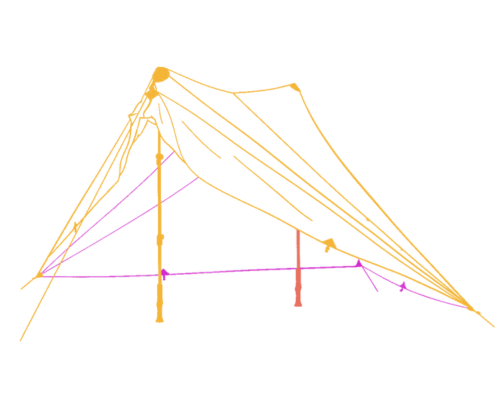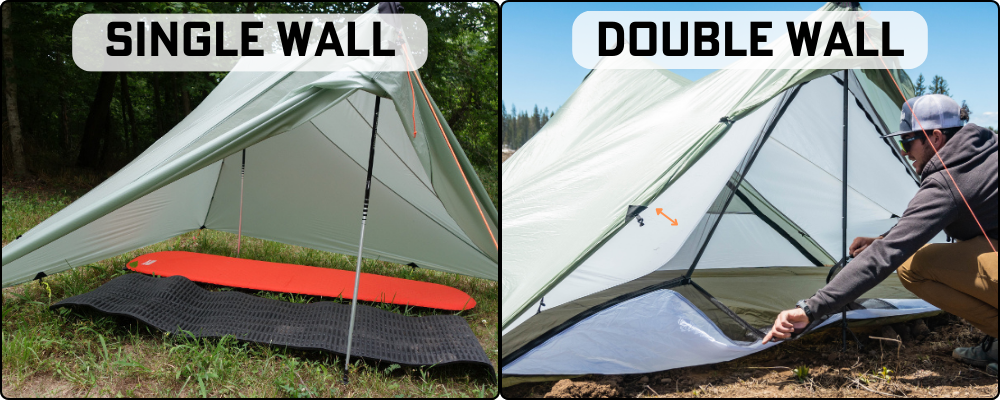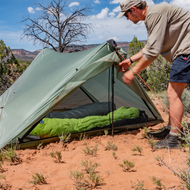Trekking Pole Tents and Tarps: What Are They and Why Should You Consider One as Your Next Backpacking Shelter?
Posted by Tyler on 15th Apr 2024
The Design:
Trekking pole tents and tarps are minimalist approaches to backpacking shelters, capitalizing on the use of trekking poles as their primary support. By eliminating the need for separate poles, these shelters aim to reduce pack weight and size. In general, trekking pole tents and tarps are known for their ease of setup and substantial weight savings compared to traditional freestanding tents.

Non Free Standing Tents vs Free Standing Tent:
Non free standing tents are different from freestanding tents because they don't come with their own poles. Instead, they typically use trekking poles, which many backpackers already have, as their main support. To set up a trekking pole tent or non freestanding tent, you need to adjust the tension of the poles and stakes to keep it upright. Free standing tents, on the other hand, rely mainly on their poles for support and don't need as much stake tension to stay up.
Tarp - Usually has multiple pitch flexibility (non freestanding).
Shaped Tarp - Usually has a much more specific pitch in mind (non free standing). More times than not, these get advertised as a tent, because shaped tarps usually have options for inner screens or nests as we call them.
Free Standing Tent - Uses a pole structure and while it does not require staking to keep its shape, it can blow away in any sort of wind if not staked out well
Non Free Standing Tent - Generally uses fewer poles, often trekking poles, linked trekking poles, or straight poles. Stakes are used to create tension and stabilize the tent.

Why Opt For A Trekking Pole Tent?
Weight Savings: One of the primary appeals of trekking pole tents is their significant reduction in pack weight. By eliminating the need for additional poles, these shelters cater to backpackers and thru-hikers striving to minimize their load without sacrificing performance.
Versatility: Trekking pole tents and tarps offer exceptional versatility, especially those with floorless designs. Many models provide options for removable inserts or nests, allowing for adaptation to various conditions and preferences.
Single Wall Backpacking Tents:
When choosing between single wall and double wall designs, it is important to note that single wall tents offer the lightest-weight-possible design. With a single layer of fabric serving as both shelter and fly, these tents are primarily seen in ultralight backpacking and thru hiking use cases. However it is important to consider condensation buildup when opting for single wall tents or tarps.
Some single wall tents may have options for nests / inserts / bug screens, (whichever the manufacturer calls it), that turn the shelter into a double wall tent. Make sure you are doing adequate product research on the design styles of each manufacturer to fully understand the intended use of the tent or tarp.
As a general rule of thumb, there exists a trade off of simplicity, complexity, performance, and weight. A tent with a separate inner can be more adaptable and comfortable, but it will weigh more. A tent with a built in inner can be simpler but less adaptable to varying conditions.

The Importance of Stakes:
Stakes play a critical role in the performance of trekking pole tents, as the primary tension points are between the peak and bottom stakes. Unlike freestanding tents where tension comes from external poles, trekking pole tents rely on stakes to maintain structural integrity.
How Are Seek Outside Trekking Pole Tents Different?
Seek Outside approaches the balance of weight, complexity and simplicity a little differently than most manufacturers. To start, we oversize our geometry to accommodate taller individuals in the shelter. We designed the Guardian 2p xl and Silex 1p xl around removable nests and stove jack options for the ability to run a wood tent stove.
Our choice of material is also a clear distinction, using custom made Cordura spec nylon. In our testing, our custom 6.6 ripstop nylon produces the best balance between ultralight and ultra durable.
Instead of selling people on 3 or 4 different tents and tarps to cover multiple applications, our goal is to send one lightweight, modular tent that can tackle most seasons, when optioned correctly.

Seek Outside's Trekking Pole Tents and Tarp Options:
DST Tarp: Seek Outside's DST Tarp is our most minimalist design, making for a great quick storm cover or a lean-to shelter with its reinforced center patch for pitching with a pole. Ideal for extreme minimalists with a bivvy or as a day hiking backup fly, this tarp serves a wide variety of backpackers and hunters.
Silex 1p xl: Balancing spaciousness and portability, the Silex 1p XL tent is perfect for solo adventurers seeking comfort without excess weight. The “xl” in the title does actually stand for “extra large”, as we like to make shelters that will comfortably cover taller backpackers (many of us here are well over 6’ tall)
Guardian 2p xl: Designed to sleep two larger backpackers comfortably, the Guardian 2p xl tent provides tons of interior space for two, even when using a tent stove.
Sunlight 2p: The first and only (as of April 2024) full tent design that we make, the sunlight features a sewn in floor and bug screen at a competitive weight. The sunlight is a large 2 person, 3 season backpacking tent, that balances weight savings and durability.
